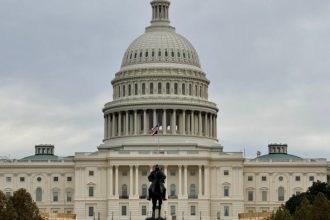President Joe Biden and Chinese leader Xi Jinping’s San Francisco summit turned into quite the gala event.
After the heads of state of the world’s two largest economies went their separate ways, Xi moved on to an event with a guest list that featured
Apple’s
Tim Cook,
Tesla’s
Elon Musk, and a host of other VIPs. Although Musk reportedly couldn’t stay for dinner, it’s easy to imagine what was discussed over cocktails.
The summit proves why China is so important. Musk and Cook need access to China’s consumer market. They’re worried about demand as well as potentially unfair competition from domestic rivals.
Biden will share those interests. He also wants to ensure global supply chains run smoothly. Xi, for his part, needs China to keep expanding quickly. The risk for China’s economy is that it grows old before it grows rich—an aging workforce makes it harder to get wealthier.
The good news is that commerce is not a zero-sum game. Both sides can win. Unfortunately, that’s not necessarily the case when it comes to global politics. Biden, like Donald Trump before him, recognizes that the U.S. can’t allow China to become a military rival or dominate the race for global resources.
Xi wants to make China a geopolitical superpower as well as an economic one. For better or for worse, it sees Taiwan as a measure of that. The deal between Taiwanese opposition parties to jointly seek the presidency with pledges of reopening dialogue with Beijing is a sign tensions may ease.
So is the agreement between Xi and Biden to restart direct communication between Chinese and U.S. armed forces. No one wants to see China’s decadeslong rise lead to open conflict.
But little else from the meeting changes the situation—there was no mention of the existing tit-for-tat trade tariffs, for example.
At the dinner Xi pondered over whether China and the U.S. are partners or adversaries and concluded China is ready to be the former. But the reality for now is that they are both.
—Brian Swint
*** Join Financial News correspondent Bilal Jafar and ex-Bridgewater executive Bob Elliott today at noon when they will discuss changes in hedge fund strategies and the potential impact of geopolitical tensions on the sector. They will also cover the 60/40 portfolio and future opportunities for hedge funds amid elevated interest rates and uncertain economic conditions. Sign up here.
***
U.S.-China Tensions Thaw and CEOs meet Xi
U.S. President Joe Biden and China’s leader Xi Jinping met for four hours on Wednesday and agreed to restart direct communications between their militaries. They also agreed to cooperate to curb the flow of precursor chemicals for fentanyl and discuss the risks of artificial intelligence as they try to keep their rivalry from spiraling into a conflict.
- When asked at a press conference if he trusted Xi, Biden responded with the need to “trust and verify.” He added: “We are in a competitive relationship—China and the U.S.—but my responsibility is to make this rational and manageable so it doesn’t result in a conflict. That’s what this is about.”
- At a dinner with U.S. CEOs and others, Xi sought to enlist corporate America’s help in easing bilateral tensions, The Wall Street Journal reported. It noted Apple’s Tim Cook and BlackRock’s Larry Fink were attendees, together with executives from Qualcomm, Boeing, Blackstone, KKR, Pfizer, and FedEx. Tesla CEO Elon Musk met Xi during the predinner reception but left before the meal.
- The Xi-Biden meeting, held on the sidelines of the Asia-Pacific Economic Cooperation summit in San Francisco, came amid a surprise move by Taiwan’s two main opposition parties to jointly back a candidate in the presidential election, which lowered the geopolitical risk level. The outcome could help improve Taipei-Beijing relations.
What’s Next: While the meeting may have taken some of the worst-case fears of a U.S.-China conflict off the table for now, enough risks persist—both related to the rivalry between the two countries and China’s economic prospects—that could keep investors on the sidelines.
—Reshma Kapadia
***
Cisco’s Sales Forecast Stokes Worries About Spending Slowdown
Cisco Systems
beat expectations for the latest quarter, but its outlook for the next one sparked worries about a slowdown in corporate technology spending. New product orders slowed in the fiscal first quarter as customers focused on installing and using products, the networking equipment maker said.
- Cisco set its outlook for the second quarter and full-year fiscal 2024, putting its revenue forecast for the January quarter at between $12.6 billion and $12.8 billion, and cutting its outlook for the full year to between $53.8 billion and $55 billion. Both ranges are short of expectations.
- Product orders were down 20% in the recent quarter from a year earlier, including a 26% drop in enterprise orders and a 32% drop in service provider and cloud revenue. Cisco has one or two quarters of shipped product orders waiting to be implemented by customers.
- CEO Chuck Robbins told analysts that an earlier bottleneck in components has shifted to customers, who are now taking time to install the “unprecedented” levels of products delivered in the previous three quarters. Orders and backlog are now at roughly normal levels, he added. But the disappointing guidance raises fresh questions about the health of IT spending this year and into 2024.
-
Cisco reported fiscal first-quarter revenue of $14.7 billion, up 8% from a year ago, and adjusted profit of $1.11 a share. Equipment providers to the telecommunications sector have seen softer demand, resulting in disappointing results from companies such as
Ericsson,CommScope,
and others.
What’s Next: Cisco’s Chief Financial Officer Scott Herren said in a statement that once customers implement large amounts of recently shipped products, the company expects to see order growth speed up in the second half of the fiscal year.
—Eric J. Savitz and Janet H. Cho
***
UAW Members at General Motors Now Narrowly Approving Contract
Unionized workers were narrowly leaning toward approving the United Auto Workers’ tentative labor contract with
General Motors
late Wednesday, reversing earlier fears that the deal ending the strike might fail to win approval after thousands of members at several large plants rejected it.
- About 54% of the 31,800 workers who had voted by Wednesday approved the proposal, and 45% said no, according to preliminary results the union released. Thousands of UAW members at several major assembly plants in Michigan, Indiana, Missouri, Kentucky, and Tennessee had voted against it in recent days.
- A GM representative declined to comment to Barron’s until after the UAW finishes its ratification process. The UAW couldn’t be reached about vote results. At 54%, GM should need only about 6,350 votes to ratify the deal, or a “yes” rate of about 42% in the remaining voting.
-
UAW members are voting largely in favor of separate contracts with
Ford Motor
and with Chrysler’s parent
Stellantis.
The three deals call for 25% raises, cost-of-living adjustments, top pay within three years instead of eight, and other benefits. - Some longtime UAW members wanted the 40% wage increases, 32-hour working week, elimination of tiers, healthcare for retirees, and traditional pensions for all workers that the UAW initially sought.
What’s Next: Even after
Toyota Motor,
Honda Motor,
and
Hyundai Motor
raised their U.S. wages after the UAW announced its deals with Detroit’s Big Three, UAW President Shawn Fain said this week that thousands of nonunion auto workers have reached out about joining the union.
—Janet H. Cho and Al Root
***
Target Beats Expectations, Sees Demand Turning Around
Target
confirmed a trend seen by other retailers in the third quarter—softer consumer demand for discretionary and big-ticket items amid rising interest rates, higher credit-card debt, and lower savings. But it is seeing some signs of demand turning around, especially in sales of home décor, apparel, and accessories.
- Third-quarter profit beat expectations, though Target’s revenue and same-store sales both fell from the same time last year. It sees fourth-quarter earnings of $1.90 to $2.60 a share and same-store sales down by the mid-single digits.
- For the holiday season, Target is rolling out more items at lower prices, including a new line of cookware and gift items for under $25. The retailer has observed that shoppers who ordinarily would buy jeans and sweatshirts in August or September waited until the weather turned cold.
- More broadly, U.S. retail sales dropped less than expected in October from the prior month, driven by a drop in gasoline prices. Taking out motor vehicles, parts, and gas stations, retail sales rose 0.1% from September. Economists had forecast a drop of 0.1%.
-
Separately, off-price retailer
TJX,
parent of TJ Maxx, forecast fiscal fourth-quarter comparable-store sales to rise 3% to 4% and adjusted earnings to be in the range of 97 cents to $1 a share. While the same-store sales projection is in line with expectations, the profit forecast is lower than expected.
What’s Next: About eight in 10 holiday shoppers are likely to buy something on Black Friday (the day after Thanksgiving), on Small Business Saturday, or on Cyber Monday, said Ted Rossman, a senior industry analyst at Bankrate. But they will be price conscious, if recent trends hold, he added.
—Sabrina Escobar and Liz Moyer
***
Thanksgiving Dinner Will Cost Less This Year
Thanksgiving dinner cooked at home is going to be nearly 5% less costly than last year, thanks to a drop in the price of that centerpiece dish: the turkey, according to the American Farm Bureau Federation, which has surveyed the cost of a traditional holiday meal for 10 for 38 years.
- The 2023 feast will cost $61.17, or $6.12 a person, the survey revealed. Nearly half of that comes from the $27.35 price for a 16-pound frozen whole turkey, down 5.6% from last year. Turkey flocks have recovered from avian influenza, which contributed to 2022’s record $64.05 meal price.
- The rest of the estimate comes from store prices observed by volunteers for the survey for a variety of dishes, including stuffing, sweet potatoes, dinner rolls, frozen peas, fresh cranberries, celery, carrots, pumpkin pie mix, pie shells, whipping cream, and whole milk.
- This year’s biggest increases came from pumpkin pie mix, up 3.8%, and dinner rolls, up 3% a dozen. Prices dropped 23% for whipped cream and 18% for fresh cranberries, because of this year’s larger supply and higher imports, mostly from Canada, said the Cranberry Marketing Committee.
- Still, the same Thanksgiving meal for 10 costs 25% more than in 2019. The traditional meal costs the most in the Northeast, at $64.38, and is cheapest in the Midwest, at $58.66.
What’s Next: Despite food inflation, Americans spend about 6.7% of their disposable income on food, the lowest of 104 countries the Agriculture Department tracks. In Singapore people spend 8.4% of their income on food and in Nigeria they spend 59%, the survey said.
—Janet H. Cho
***
People looking to buy a home know all about high mortgage rates and plunging affordability levels, but what about the down payment? The National Association of Realtors found the typical down payment for first-time buyers rose to 8% in 2023, up from 6% last year. It’s possible to put down much less. Some lenders, such as Zillow and Rocket Mortgage, are offering 1% down payments to make homebuying more affordable in this market.
For more, read here.
—Aarthi Swaminathan
***
—Newsletter edited by Liz Moyer, Patrick O’Donnell, Rupert Steiner
Read the full article here





